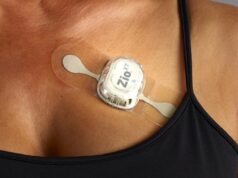
Results of the Fitbit Heart study, presented during a late-breaking science session at the American Heart Association’s Scientific Sessions 2021 (AHA 2021; 13–15 November; virtual), suggest that the consumer fitness tracking watch, Fitbit, was capable of detecting undiagnosed atrial fibrillation (AF) around 98% of the time.
The study, conducted from May through October 2020 by investigators from Massachusetts General Hospital (Boston, USA) enrolled more than 455,000 adult smartwatch or fitness tracker users from across the USA who, if notified of an irregular heart rhythm detected by a software algorithm within their wearable device, were invited to a telehealth consultation and screened using a one-week electrocardiogram (ECG) patch monitor.
Presenting the findings at AHA 2021, investigator Steven Lubitz (Harvard Medical School and Massachusetts General Hospital, Boston, USA) detailed that data from the devices were analysed using a novel software algorithm with frequent overlapping photoplethysmography (PPG) pulse tachogram sampling. The investigators tested the algorithm’s positive predictive value for undiagnosed AF.
According to Lubitz, the analysis found that the algorithm was able to successfully detect AF, and the findings were consistent across age groups. Irregular heart rhythm detection occurred in 1% of individuals overall and 4% of adults older than 65 years, he noted. Among individuals who received notification of an irregular heart rhythm, 32% had atrial fibrillation detected on a subsequent ECG patch monitor, Lubitz reported.
The ECG patch confirmed atrial fibrillation in 98% of individuals who had another irregular heart rhythm detection while wearing the ECG patch monitor. For participants over 65 years old, a subgroup at elevated risk for stroke caused by atrial fibrillation, the algorithm corresponded to concurrent AF 97% of the time.
“These results show that wearables have the ability to identify undiagnosed atrial fibrillation with high reliability,” Lubitz said. “Since so many consumers use wearables, it is possible that algorithms such as the one we studied could be applied widely to help identify undiagnosed atrial fibrillation, allowing patients to obtain care before devastating complications such as a disabling stroke may occur.”
He added: “Most of the episodes of undiagnosed atrial fibrillation detected occurred during sleep, and we suspect that these episodes were asymptomatic. Since the algorithm is most active when wearers are physically inactive, the wearable should be worn during sleep for the greatest benefits.”
The algorithm is currently being reviewed by the US Food and Drug Administration (FDA) for clearance and widespread use. The study did not test whether screening for AF leads to a reduction in strokes, which Lubitz notes is an opportunity for future research.
Providing commentary on the findings following Lubitz’s presentation at AHA 2021, Mintu Turakhia (Stanford University, Stanford, USA), who was among the investigators on the Apple Heart Study, which used the Apple smartwatch to identify possible AF, highlighting some of the concordant findings of the studies, as well as key differences in the data.
Turakhia noted that there were differences in the rate of notification between the two studies—0.52% overall in Apple Heart, 3.2% in those aged ≥65 years, compared to 1% overall in Fitbit Heart and 3.6% in those aged ≥65 years. Positive predictive values were also noted as being different between the two studies, 84% in Apple Heart and 98% in Fitbit Heart, while the AF yield on subsequent ECG was similar between the two studies, measuring 34% in Apple Heart and 32% in the Fitbit Heart study. “I believe that both of these algorithms identify patients, participants or consumers early in the course of the disease,” Turakhia said, commenting on this last piece of data.
However, Turakhia noted that engagement was an important limitation in both studies, with the percentage of those who received a study visit measuring less than 50% in both trials. “We clearly need to do more in this area to really do better,” he said.
Turakhia said that the findings of both studies taken together suggests that the algorithm measures “what it is supposed to”, and that Fitbit and Apple devices are broadly comparable in terms of performance. He added: “I would argue that this is not classical screening that we would think of in public health, this is one of many opt-in consumer algorithms that are showing change from baseline, there are other companies doing this. The big challenges are engagement, designing this for people with AF, and post-market safety.”









